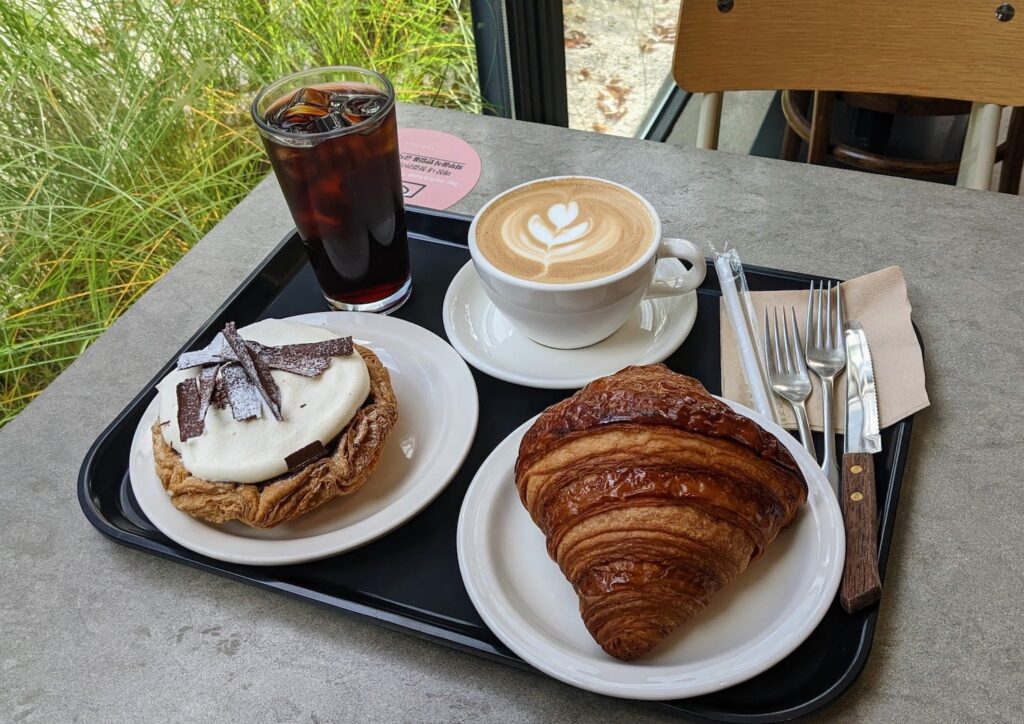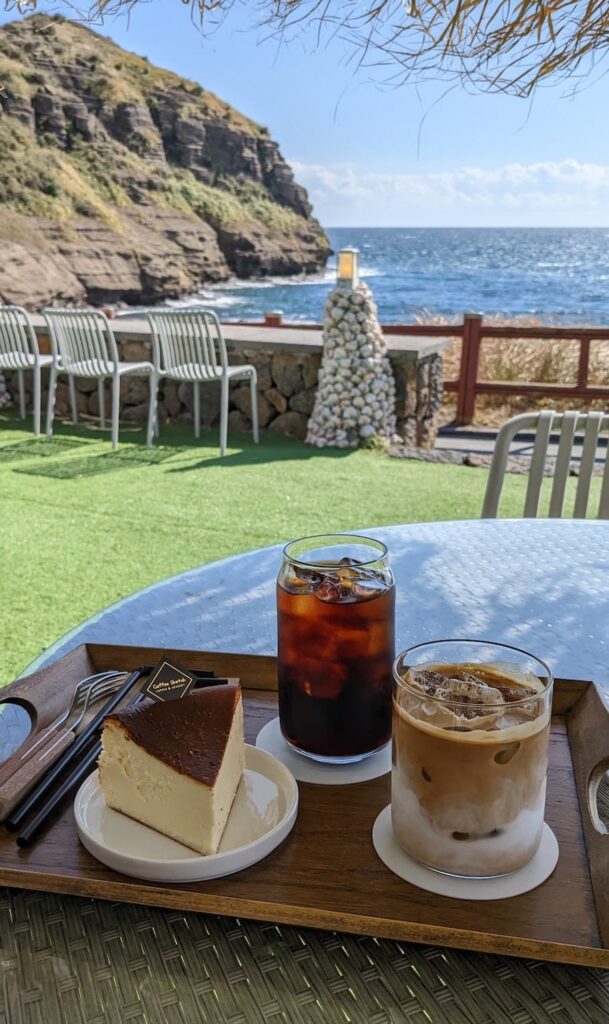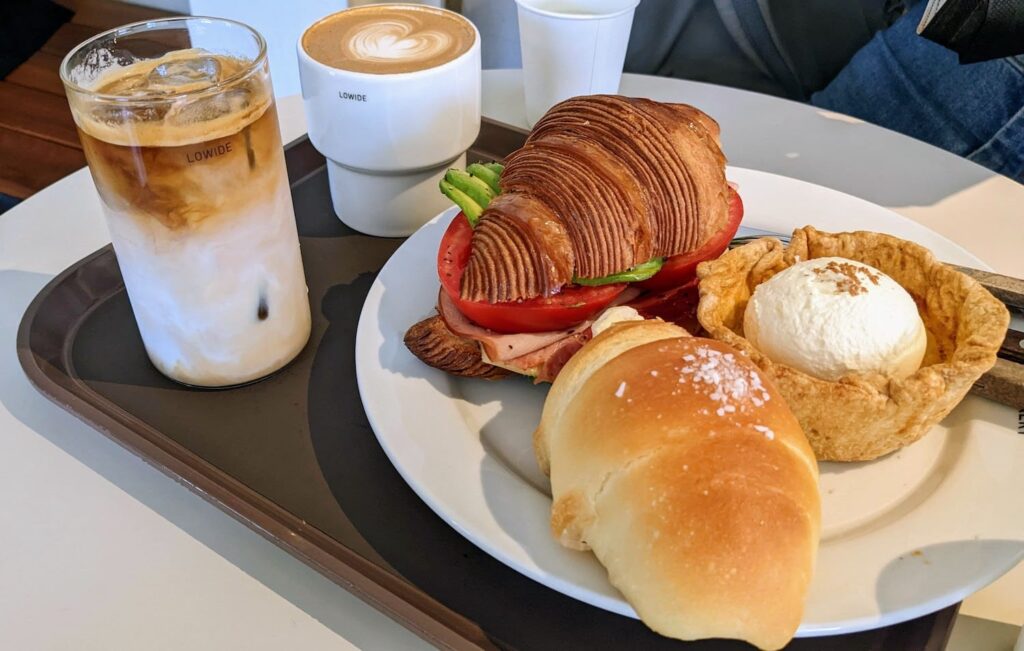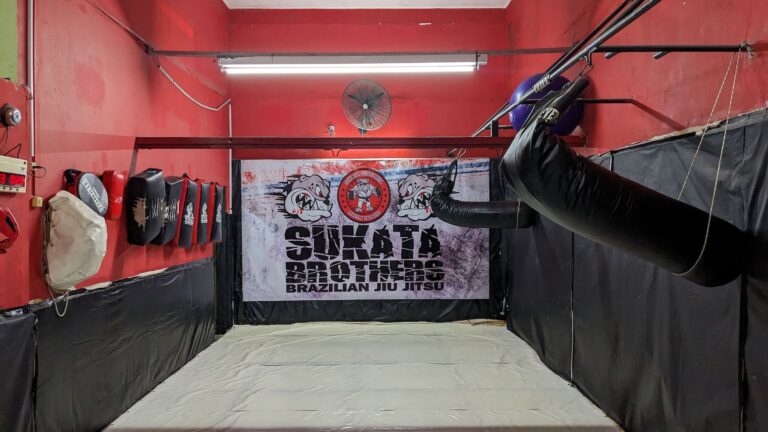Living in Seoul, Korea — A Review
For three months, we stayed in Seoul, South Korea as temporary visitors — doing our best to live a reasonably normal life, learn as much Korean as possible, and get a good feel for the city. We had a lot of unanswered questions about living in Seoul, so decided to put together this guide.
Living in Seoul as remote workers / temporary visitors is different from most non-Koreans who come here, who come as either teachers or students enrolled in a school. We came the way we usually travel — renting our own apartment, and figuring out our own way of learning about Korea and Korean culture as effectively as possible.
But before we came here, we found it quite hard to figure out a number of things about Korea, despite the number of foreigners who’ve been through.
We wondered about things about living in Seoul like:
- What’s the best way to learn Korean, through a school or through private teachers?
- What’s the English language level like if you don’t speak Korean, or as you’re getting started?
- What’s the outdoor scene like? There are lots of mountains…
- Is it easy to eat well in Korea? Is food expensive?
- Are people nice? Is there racism?
- What is the general cost of living in Seoul?
- How does one stay fit?
- How does one get around Korea?
- Is the internet / mobile speed good?
Anyway, here’s everything we found out. Enjoy!

Contents
Living in Seoul — An Overview
Overall, living in Seoul is often very interesting, sometimes very frustrating, randomly expensive and cheap, and occasionally just impossible.
Accommodation is by far the most expensive thing about living in Seoul. If you want to spend less than $1500 a month… you should probably look elsewhere. In Korea, that amount will get you a studio apartment. You may find some for slightly cheaper, but they’ll start getting smaller and more remote.
Of course, if you’re staying here longer term, you can pay less for accommodation — a decent one-bedroom should set you back around US$500 a month. But that would be for someone living in Seoul or Korea for at least a year, which isn’t what this article is about.
Where to Stay in Seoul
There are a few major options for where to stay in Seoul. Of course, you can live anywhere, but we’re presuming you want one or more of things like: culture, a “local” feeling, or accessibility to nightlife or your place of study.
Don’t stay in Myeongdong. It’s just a tourist trap, mostly for huge group tours, and the stuff there is old. There’s some “fake” street food; it’s mostly put on display because tourists have come to expect it.
Instead, stay in one of the following commonly recommended places.
Hongdae
Hongdae is a great place to visit if you’re a visitor and your Korean is non-existent or you don’t plan on learning it.
There are lots of cafes and nice shops around, and people will generally have English menus and even serve you in English.
Gangnam
Gangnam has great nightlife, transport, and restaurants. But outside the most bustling parts of it (and even in that part of it!) you generally need to know Korean.
Gangnam is expensive generally. You’ll see Ferraris and Teslas. But that said, accommodation there can be cheaper than other parts of the city, depending on how far from the busy parts you are.
We stayed in Yeoksam, in the Gangnam district, but south of the busiest parts. We rarely saw foreigners in Gangnam. The further south you go from the river, the less people speak English.
Insadong
Insadong isn’t quite as bustling as Gangnam or Hongdae, but it has a lot hipster eateries, cafes, and culture. It does get its share of international visitors though. Like Hongdae, it’s easy to find English speakers there.
Culture in Korea
In general, people in Korea are very nice, patient, and accommodating.
As background, we’re both “Westerners”, but with colour — we’re a Korean American and a Persian Australian.
Before coming here, we were vaguely worried about a degree of discrimination. Foreign Koreans are sometimes looked down on, and people from The Kingdom of Brownestan tend to attract their share of prejudice, whether people think I’m from India or from an Arab country.
But actually, living in Seoul, we didn’t notice any obvious culture-specific xenophobia. We generally were treated like “foreigners” everywhere we visited. This means roughly being treated the same way as any person from any other part of the world: someone who doesn’t speak the language (even if we did), is probably culturally ignorant, and may not know how to do things, but is still welcome.
That’s how we generally felt — welcome. There wasn’t a single time we didn’t feel welcome in Seoul. Sometimes I’d ask a stupid question, like “Excuse me, but how do you eat this food?” (I don’t know, there’s like seven elements to it! Which bits go with which?), and they’d just tell me. I didn’t sense any judgment. Maybe they do judge me, but it wasn’t obvious.
Similarly, sometimes people would look at us in the subway or on the street, but never for a protracted period, and never in a way that made us feel uncomfortable. If there was a free seat next to one of us, people would sit down next to us. (OK, once someone moved away and I was initially offended, but then I notice everyone likes to move away from anyone, to create space where possible.)
Some of this may be obvious. Koreans reading this will think “Well, of course.” But the truth is we heard quite a few contrasting stories before arriving in Seoul in which people told us Koreans are rude, so it wasn’t all obvious to us.
In general, Korea is a very quiet place. It’s quiet on the street, on the subway, and inside buildings. People don’t yell. In fact, people rarely even talk. It seems like talking on the subway is forbidden.
The one exception to quiet is restaurants, which can be raucous, depending on the eatery. Raucousness is a virtue in Korean eating! See the below section on food culture.
Koreans share many values that one could generally describe as being “Asian” values. For foreigners living in Seoul, we experience these things like: respect for elders, using polite language when addressing strangers, and generally showing deference. Koreans have a few very specific Korean things they do, like sometimes avoiding eye contact, and definitely bowing more than in many other places (much more than in China, and maybe a similar amount to Japan).
Korea also has a strong tie to its history. Even though South Korea was born as a nation relatively recently (splitting with North Korea in the 20th century, after long war and an ensuring period of very hard times), Korea still fondly remembers the imperial period hundreds of years ago, known as the Joseon period. There are lots of dramas set in that time. And there are parts of town where if you wear period costume, you get into the parks for free.
Making Friends in Korea
One of the hardest things to do in Asian countries is to make friends with locals.
I generally find this very hard living in Seoul, too. Aside from other language students and my language partners/teachers, I’ve always struggled.
One thing I’ve figured out is to find a community of people who do a hobby or sport with me. If you don’t have one of these, I highly suggest you figure one out before arriving in Korea.
Some things that are popular group activities in Korea are
- Hikes — you can find hiking groups online
- Sports like baseball, soccer, and golf (golf is disproportionately huge!)
- Martial arts like judo, hapkido, jujitsu, or MMA. Taekwondo is obviously big but mostly done by kids, just be aware, or serious professionals.
- Games and esports — Korea is huge on gaming
You can find clubs for all of these things relatively easily.
I’m sure there’s plenty of other stuff that’s social and where you can make local friends, like dance, arts, and so on. They’re not things I really know about, but think about what you like and get creative.
Even though I make friends while living in Korea via these means, I find it’s quite hard to form close connection with people who are monolingually Korean, for obvious reasons. My friendships tend to be mostly non-verbal, e.g., playing with someone rather than talking intensely about our lives. This isn’t too different from how I make friends in any other country, however (not everyone is good at conversation).
But in Korea, don’t expect to get to intimate stages as quickly as you would for example in the US or in Europe. In the US, people invite you over to parties pretty quickly. I’ve found it takes longer in most parts of the world, and Korea is no different (though not as slow as China!). Part of the reason for this is that people’s homes in Korea tend not to be huge — housing is very expensive.
Fashion / Obsession with Appearance in Korea
Korea is well known around Asia for being one of the fashion hubs, if not the biggest fashion hub. Korea exports a lot of culture, including K-pop, Korean dramas / celebrities, fashion, and makeup.
I’m not a big fashion person, but I just want to say that fashion, beauty, and aesthetics are very, very important in Korea, to the point where it makes many non-Koreans a little uncomfortable at times. Yes, it’s nice and important to take care of oneself. But a few ways in which Korean values on aesthetics make living in Seoul appear, to some people, a little superficial.
For example, there’s a huge emphasis on physical beauty that’s often modified through plastic surgery. Many Koreans with the means (and it’s cheaper if you’re local) get nose jobs, double eyelid surgery, and other cosmetic surgery.
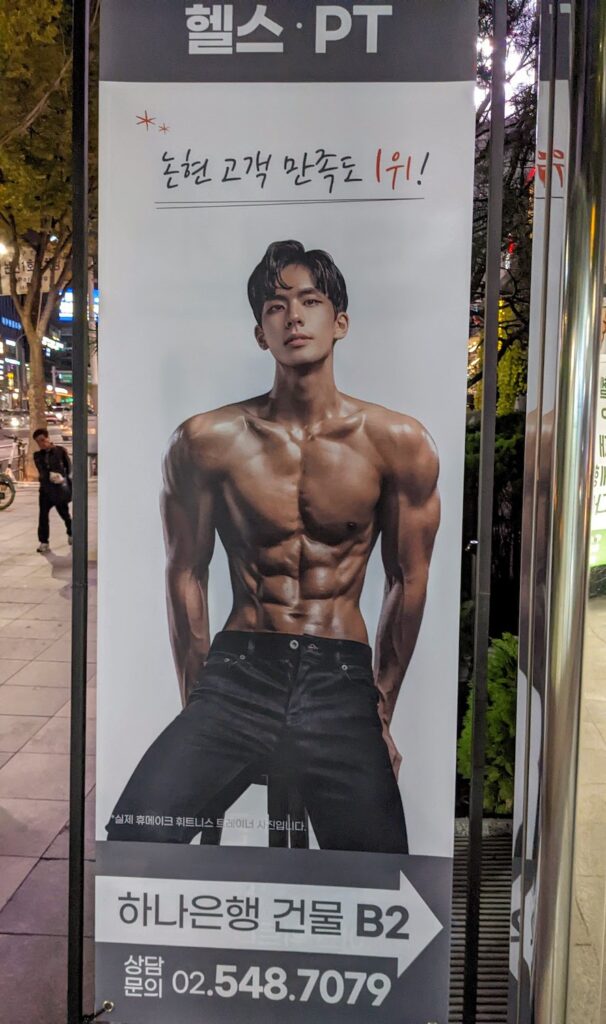
It’s not that cosmetic surgery is not done in other places — of course it is. But it’s treated differently in Korea. People talk openly about parts of their face they’re not happy with. Parents gift cosmetic surgery to their kids when they come of age. People sometimes even shame each other (even if gently) and suggest they get surgery.
And we’re not just talking a nip and tuck. Then there are many more extreme levels of surgery that are quite common, like jawline and cheekbone modifications, and lots of other stuff that significantly affects how people look.
The emphasis on physical beauty in Korea also leads to a lot of open “photoshopping” of selfies in photos and ads. Again, this is also a problem in many non-Korean countries, but it’s much more widespread in Korea. It leads to some weird outcomes, like disproportionately small heads, like in the pictured ad for a gym I saw in Gangnam.
If you’re overweight, people will look at you, may comment on your weight (if they speak your language), tell you that you should go on a diet, or comment on food you’re eating. It may even be playful or in good nature (not mean), but it’s open and casual.
Also, if you plan on doing shopping and you’re above normal Korean sizes, it’s much less likely you’ll find clothes in your size.
There is a strong culture in Korea of preferring light-coloured skin. Many east Asian countries have this, but Korea has a huge cosmetics market focused on skin lightening, which they export a lot to other countries. People cover up a lot, not just out of modesty, but also to avoid their skin becoming darker — for aesthetics, and then only for incident health reasons.
With all that said, it’s totally possible to find environments where nobody talks about beauty. There is a strong alternative subculture in Korea where people are very open minded in their thinking. But it’s all on top of Korean society that’s largely a bit more superficial than most others.
As a final point about fashion — fashion conservative in Korea. Women always cover their shoulders and don’t show cleavage. Men and women generally prefer long pants and sleeves, though short sleeves are fine. Tattoos and piercings are rare (unless you’re a bit non-mainstream), as are very flamboyant hairstyles. It’s quite common to observe many people dressed largely the same — even if they are dressed well.
Where to Work in Seoul / Korea
One of the best parts about living in Seoul as people who work on laptops is that cafes in all of Korea are VERY laptop-friendly.
Maybe aside from lunch hour in a busy area (and even then, I was never kicked out — I just felt guilty), you can order a coffee, find the Wi-Fi password if it’s not obvious (often on a sign or on the receipt), and start plugging away.
I mean every cafe is laptop-friendly. There’s always a couple in there.
Aside from cafes, there are cafes denoted as study cafes, and lots of coworking spaces… but I never tried those as they looked unnecessarily fancy and I preferred my local cafe where I had a points card. Besides, I just picked a nice Airbnb and usually end up working from home.
I did try working outdoors a few times, too. That also worked — it was easy with my phone and unlimited data. But I got cold!
Safety in Korea
Korea is very, very safe — with caveats. I’d liken it a lot to China, for example.
Firstly, there is little to no theft. For example, even in a busy touristy area, the way you reserve a table isn’t by leaving your coat there — you put your cellphone on the table. Nobody will steal it. You then go order (even if it’s out of sight of the phone!) and come back.
So don’t worry about theft, pickpockets, or so on in Korea. People are very honest that way. I’m not sure why — partly cultural, and partly because there are security cameras everywhere, I’m sure.
Secondly, we never felt like we were in a sketchy part of town. I never thought I’d get mugged. I never worried who was standing behind me if I was changing money.
Thirdly, there are no guns in Korea. Nobody has guns. I suppose some people might have knives, in some sketchy places.
Finally, Korea is very safe for women — with a caveat.
The caveat is that sometimes there is unwelcome touching of women, and foreign women do report being harassed and stalked in strange ways. To combat this, at rush hour there’s a separate car for women, for example. And if you’re a foreign (non-Asian descent) woman — just be aware that some guys can be creepy.
Join the Expat Women in Korea for more info on this.
If you go looking, you’ll hear a lot of stories, and they should put you on guard. But I wouldn’t say Korea is “unsafe”. Women (including foreign women) walk around solo all the time. It’s just that it has its share of creeps.
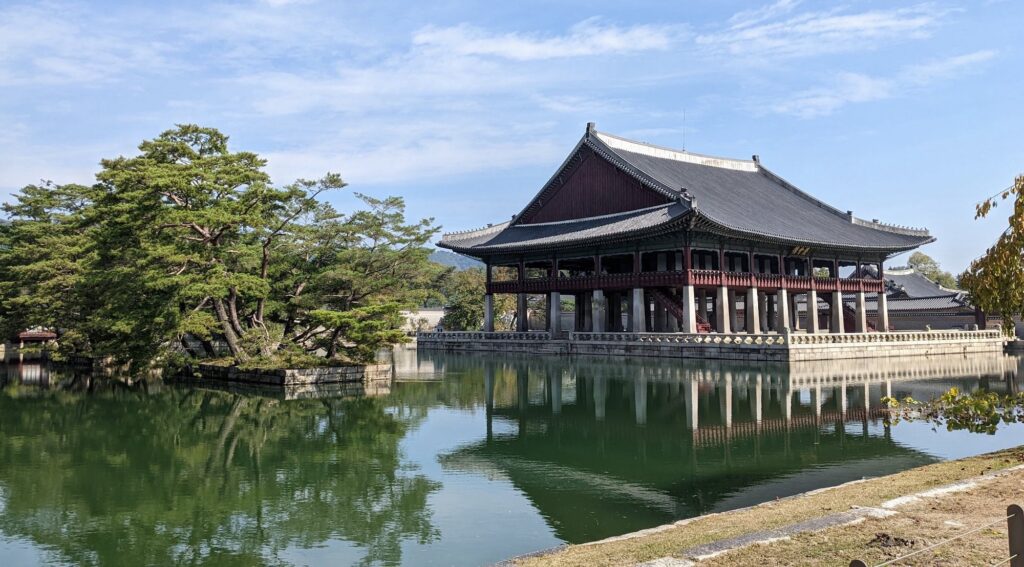
Language in Korea
The summary of this section is: No, you don’t need to speak Korean in Korea, but you should learn the basic phrases to be polite, and realise your opportunities to do things will be constrained outside of central Seoul.
Needless to say (I think), people living in Seoul or anywhere in Korea speak Korean primarily, and often uniquely.
We came to Seoul mostly to learn Korean. In general, I think it’s a very hard language — as hard as Chinese.
In a nutshell, Korean is quite hard because the grammar is complex (sentence order changes dramatically, and there’s a lot of nuance expressed through grammar), the words are all alien-sounding to English speakers, it’s in a different script, and there are tons of homophones which are hard to pick apart — unless you already know Chinese (or Japanese).
See my article with longer discussion on how hard Korean is for English speakers.
Korean is a very interesting language, though. It has strong ties to China in terms of vocabulary. In fact, at one point, Korean was written exclusively in Chinese characters, and would have been considered a Chinese language. But apart from the roots of many words, it has very little in common grammatically with modern Chinese.
And Korean shares a lot of grammar and sentence structure characteristics with Japanese.
The important thing for foreigners living in Seoul is that even in Seoul, most people don’t speak English well. But in developed parts of the city, you can definitely expect people to know a little. For example, in the touristy parts of town, people will happily speak just enough English to sell you things. And in nearly every cafe, co-working space, or gallery, someone will speak defensible enough English to tell you what’s on offer.
However, don’t expect extended conversations in English.
I’ve really tried to speak just Korean most of the time I’ve been living in Seoul (I self-studied for two years before coming, doing roughly 30 minutes a day on average). But there have been times I’ve needed to speak English (e.g., to a doctor), and where I’ve seen it spoken to other people, so I have observed how good English might be.
Here’s an overview of English you might get:
- In restaurants, it depends on how local the place is. In a very local place, you should absolutely look for a place with a menu with pictures (quite common). Most small places are this “local”. You can expect menus in these places to have zero English on them. But in bigger restaurants and franchises, you’ll get a picture menu, but the staff probably still don’t speak any English. I remember a tourist just saying “soup” clearly and repeatedly. The waitress didn’t understand and repeated back “kuk-su?”, which means noodles. So, forget asking “What do you recommend?” in English in smaller places.
- In touristy parts of town (e.g., north of the river), people will speak enough English to give you recommendations of things to do. But don’t expect an extended discussion about anything, in case you were hoping to really connect with your barista for some reason.
- In hospitals, do not expect most staff to speak English. If you speak with a doctor, they may speak English, but it’ll be halting. However, they’ll know all the important terms (arguably the most important bit!)
- For online services, English is almost never an option (because they’re unavailable to foreigners anyway).
So, what are you to do? Basically, you’ll probably have to do a lot of guessing and pointing at things. But the plus side is that people are patient and friendly, and I’m sure you’ll get by.
Should you be able to read Korean?
It’s tempting to say you should be able to read Korean, just to be able to read menus. But it won’t get you very far.
I’d suggest that most people
- Learn to read Korean
- Learn the 20-30 or so favourite dishes they like to order, and be able to spot them easily. I mean things like
- Gimbap — 김밥
- Fried chicken — 치킨
- Americano — 아메리카노
- Flat white — 플랫화이트
- Galbitang — 갈비탕
- Kimchi jjigae — 김치찌개
- Pork belly — 삼겹살
In that way, at least you’ll be able to point at the many text-only menus.
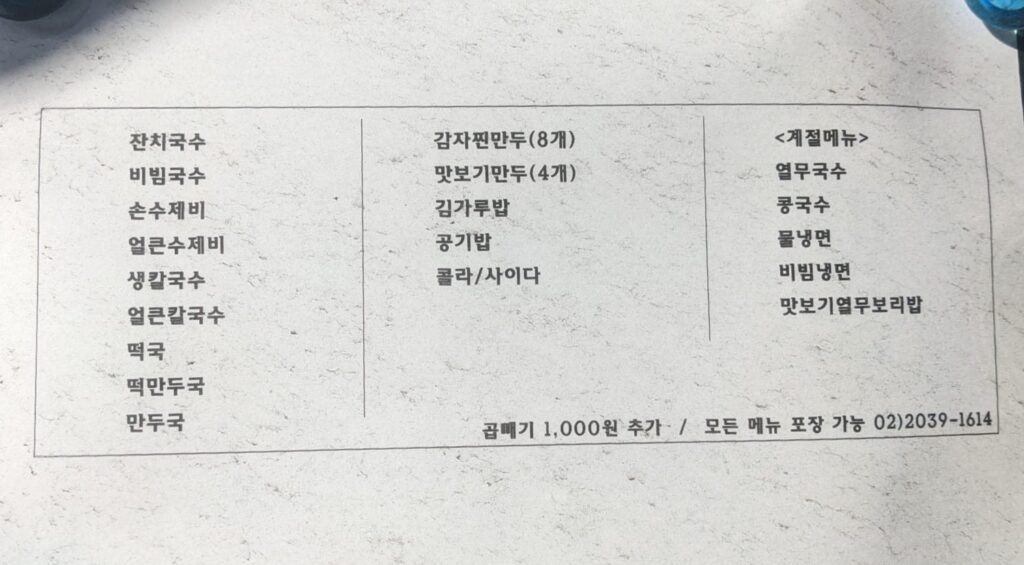
You’ll still come across many text signs that are impossible to decipher unless you can read the words and understand the grammar, like the one below saying to take off your shoes before coming in.

Essential Basic Korean Phrases You Should Know
This is a huge topic, but I’ll get it started with some basic Korean phrases that you absolutely must know. Some just to understand, and the others to say.
| English phrase | Korean | Transliteration |
|---|---|---|
| Welcome (You’ll hear this, and never need to say it) | 어서 오세요! | eoseo oseyo! |
| Hello! | 안녕하세요! | annyeonghaseyo! |
| Are you open now? | 지금 영업 하세요? | jigeum yeong-eob haseyo? |
| I’ll have this, please. (“Please give me this”, pointing) | 이거 주세요. | igeo juseyo.. |
| Please give me one of these. | 이거 하나 주세요. | igeo hana juseyo. |
| Excuse me! (to owner / waiter) Use the former to a man, the second can be used for anyone. It’s sexist but it’s what I’ve seen. | 사장님! 여기요! | sajangnim! yeogiyo! |
| Please give me water. | 물 좀 주세요. | mul jom juseyo. |
| I want to order take-out. | 테이크아웃을 주문하고 싶어요. | teikeuaus-eul jumunhago sip-eoyo. |
| One / Two people. | 한명 이요 / 두 명이요. | hanmyeong-iyo / du myeong-iyo. |
| The check, please! | 계산서주세요! | gyesanseo juseyo! |
| Thank you | 감사합니다! | gamsahabnida! |
| Where is this? (pointing at something) | 이거 어디에요? | igeo eodieyo? |
| Where is the bathroom / toilet? | 화장실 어디예요? | 화장실 어디예요? |
| Goodbye (as you’re leaving) | 안녕히 계세요! | hwajangsil eodiyeyo? |
| Goodbye (they’ll tell you, as you leave) | 안녕히 가세요! | annyeonghi gaseyo! |
Food in Korea
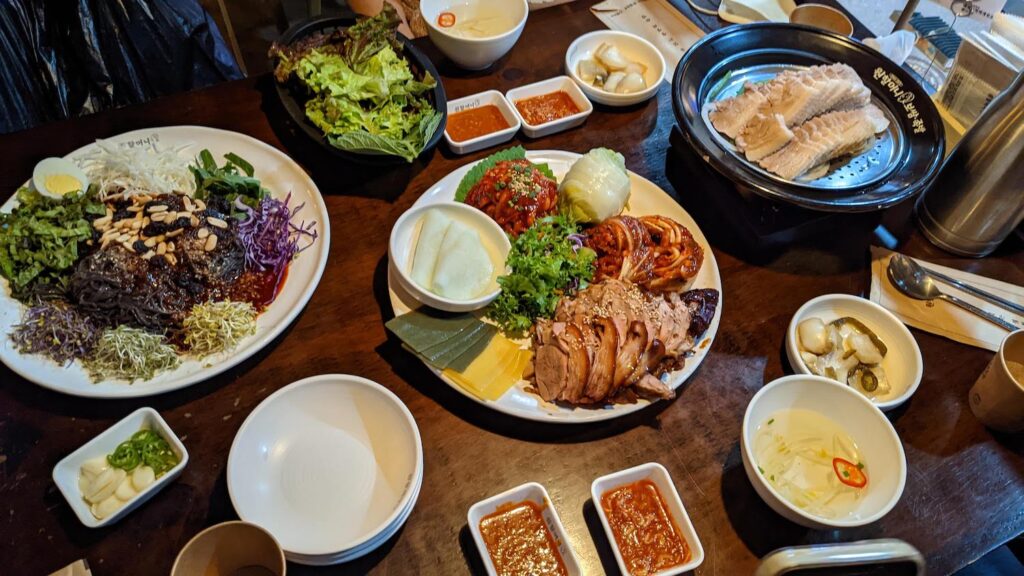
How did it take this long for me to get to food? Food is one of the main draw cards of living in Korea!
Eating out in Korea is cheap (relative to everything else, and to other countries), interesting, diverse, healthy, and delicious. And there’s a lot of kimchi.
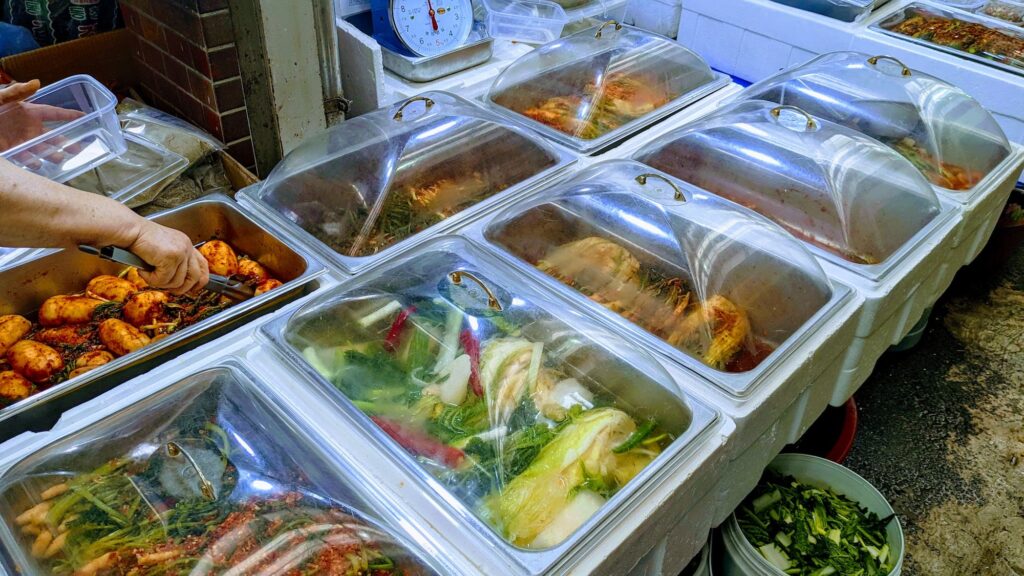
There are many, many kinds of interesting foods worth trying in Korea. I’ll make a longer post on this later.
But in general, here’s a few things about eating in Korea that I like.
- You always get side dishes. Every Korean meal comes with at least kimchi as a side dish, plus multiple other side dishes (반찬), little pickled or savoury things that complement the main side dish. And always kimchi at a minimum.
- There’s a wide variety of “types” of Korean food. A number of types of Korean food off the top of my head are: hot noodles, cold noodles, rice mixed with things (like the famous bibimbap), gimbap (a bit like sushi rolls), deep fried chicken (better than any you’ve ever had), soups, barbecue, dumplings, porridges, stews, cooked fish and meats, and the many variety of side dishes that go along with all of those. In each of those categories there are dozens/scores/hundreds of individual dishes.
- Korean food is cheap. Even in an expensive part of town, we can have a full meal for under 10000 won or US$7 at these days’ rates.
- Korean coffee culture is fantastic. As an OG coffee nerd who has been roasting and brewing every kind of coffee for decades, I haven’t had a bad coffee in Korea — espresso, brewed, and specialty drinks. I also appreciate the interesting things they do with texture (like crunchy toppings!) and sweetness.
- Korean food is ubiquitous. There’s no street without Korean eateries on it. Every convenience store has surprisingly delicious snack foods (e.g. gimbap) and even prepared meals in it.

There are a few downsides to eating in Korea, however
- Like many Asian countries, vegetarians and vegans will struggle. I know stuff is available, but it’d be limiting, more than in most European / North American / APAC countries.
- Loads of sugar. Koreans seem to put sugar in everything. And lots of other carbs, i.e. rice and noodles, if that’s not your thing.
- Lots of peppers/spice. If you can’t do hot food at all, you’ll struggle in Korea. There’s Korean peppers in a lot of things (not everything, though).
- It’s quite hard to get most “western” foods other than pizza and burgers (and those are quite Korean style, e.g. a bulgogi pizza). If you really want a loaf of heavy, nutty bread… bring it with you. Or pay a huge foreigner’s price somewhere, I don’t know. If you’re French, do not get the baguette from Paris Baguette. Their cakes and soft breads are good, though!
- Desserts are OK, but they won’t rock your world like they do in France and Italy. This is somewhat ironic given that sugar is in everything! Desserts are still better than most parts of the world, though. Of course, you can travel around the city and find a good chocolatier or dessert place, but it’s hard.
Eating Healthily / Affordably in Korea

It’s easy to eat out; but it’s harder to eat healthily, and even harder to eat healthily and affordably living in Seoul.
In many other countries, what I’d do is go to a local supermarket, buy ingredients, and cook at home. The problem in Korea is that supermarkets are expensive. It often costs me MORE to cook my own food than to buy it out (even when making the same thing). Families figure out ways to economise, but that’s more of a scale thing.
There are three things we figured out that helped us to eat healthily and affordably while living in Seoul.
- Find the more affordable supermarkets. I like a few local ones, like “Nobrand” (a bit like Aldi), which sells much more affordable but still good-quality food.
- Choose meal kits, not individual fresh vegetables, sauces, and meats. I like to buy meal kits that can feed two people (with leftovers) for anything from 7000 to 15000 won (about $5-12 at current rates). They’re a bit like Hellofresh but you get them from many supermarkets (including E-Mart / Nobrand etc.)
- Buy stuff at local traditional markets (전통시장). That’s where I’d get my kimchi, banchan, and some meats, fruits, and vegetables. Looking on Naver Maps it’s easy to find the nearest one near you.
- Buy in season. For example, we stayed in Seoul in the Autumn / Winter season, so the fruits we ate started out as grapes and melons, then apples, and ended up as persimmons, tangerines, and strawberries.
Local markets are the most affordable way to buy things. You can probably get a lot by pointing, and many signs are fairly self-explanatory. But it’s here that you’ll benefit from knowing some basic Korean.
Fresh fruits and vegetables are quite expensive in Seoul in places like supermarkets, but if you find local markets, you can find fruit in season very affordably. I wrote this section after eating a whole giant Korean pear, which is almost a luxury item, that cost me 1000 won (about 70c).
Quick side note: Coffee is great, but often basically a dessert in Korea
Coffee culture in Korea is fantastic. Pretty much every local cafe has a nice espresso machine by one of the big Italian brands, has quality beans, and knows how to do a flat white or latte that’s a far cry from Starbucks.
Many cafes even roast their own beans and do things like drip and pour-overs.
But what really makes me think differently of Korea is that many places consider coffee drinks to be a treat — yes, a pick-me-up, but one that’s loaded with sugar.
I’m not just talking about things like caramel macchiatos (though you’ll find those). Korean coffee drinks do creative things with oreo cookies, cream, ice cream, candy, crunchy sprinkles, boba, and much more. I didn’t experiment too much, generally suffering from sugar overload in Korea in general, but I did enjoy the things I tried. Here are a few of the coffees I enjoyed while living in Seoul for your enjoyment.
Getting Around in Seoul
Seoul is massive and complicated. It takes us anywhere from 30 minutes to over an hour to just get to other relatively nearby points of interest.
But luckily, the public transport system is extensive and well-functioning. The buses and metros are clean, you can often get a seat (aside from rush hour), and nobody shoves (other than pushy aunties).
In short, get a Tmoney (티머니) card, also known just as a transport card (교통카드). There are a couple of options, but Tmoney is the most common kind.
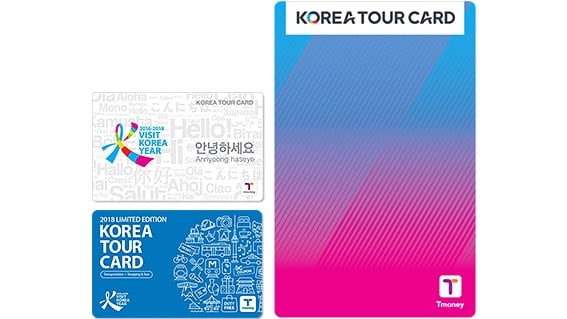
You can buy these cards from vending machines. They cost 2500-5000, though we only found ones that cost 4000-5000.
You can recharge them from any metro station using an automated machine. But you can only recharge them with cash! Locals can do it with a credit card, but that’s not an option for foreigners.
Most trips around Seoul cost us around 1200-1500 Won. So it makes sense to recharge it with at least 20000, or more if you plan on commuting every day.
You can use your Tmoney card on both the metro and buses. Even on little regional buses. It’s a pretty good system.
For navigation around Seoul, I highly recommend you use one of the local apps. Kakao Maps is best for navigation, but Naver Maps is also very good. Naver Maps is better for discovering places like restaurants and points of interest, though.
The apps don’t integrate perfectly with reality of buses and metro lines, though, in a few ways, which makes navigating public transport slightly tricky.
Firstly, it’s a little tricky to figure out which direction you need to go in. Signs in metro stations don’t tell you something easy like “westbound” or the final destination. Instead, they tell you a few random stops along the way, or maybe the next stop. This doesn’t always correspond with what you see in the app. So you need to poke around a bit to see exactly which direction you need to go.
Secondly, you don’t get live information about how long it will be until the next bus or metro. It’s usually accurate to within a minute, but it’s not like other major cities where it’s like there’s a transponder on the vehicle telling the system exactly where it is.
Finally, the apps don’t always accurately know how long it’ll take to transfer between lines. A walk that’s something like “200 metres” may be ten minutes of snaking your way through tunnels. Just be prepared for small delays and you’ll be fine.
The Alien Residency Card (ARC) / 외국인등록증
To do a lot of stuff in Korea, you need what’s called an Alien Residency Card (ARC) or 외국인등록증. We never got one of these.
To get an ARC, you need a visa, which means you need to be living in Korea for a formal study program or for a job.
Since people doing the digital nomad / remote worker thing don’t have a normal visa, this is basically off limits.
Some things you need an ARC to do while living in Korea are:
- Order food online
- Order digital online services
- Use online payment platforms like Kakaopay
- Get a local bank account or credit card
- Get a phone plan
You can do a very limited subset of those things without the ARC, but it is all a lot harder (e.g. calling a restaurant and ordering over the phone in Korean).
Online commerce in Korea: Forget about it!
Korea has a great tech industry. But it’s basically closed off to you unless you’re a resident living in Korea long-term (i.e. with a job or student visa).
To do any online commerce, you need to have a) a local sim card, b) an alien registration card (ARC) that’s linked to your sim card, and c) a local bank account. You need that ARC to get the sim card and bank account. Sometimes you need d) a local credit card (not just a debit card).
To do all those things you need a long-stay visa for living in Korea, not just a tourist visa.
The reason for this is that every online system requires you to authenticate your identity. This is partly to prevent fraud and crime. The price of online security is eternal vigilance of your every transaction. It’s a very “big brother” kind of approach.
This means that as a foreigner living in Korea you can’t:
- Use any online commerce: you can’t order products or groceries from local online supermarkets
- Order food from most of the apps: You can still use one of the apps, Shuttle, but it’s priced higher, and mostly only available north of the river (not in Gangnam)
- Buy online video or game streaming services
On top of that, a few major overseas businesses don’t work in Korea. Uber and Lime have both exited the market. So there’s no Uber Eats.
Some Korean services that you can use overseas still work in Korea, though. You can use Kakao Taxi to order taxis, for example. (I’m not sure if you can pay for them, but I think you can’t.)
Payments in Korea — No Touching!
You can use credit cards basically everywhere in Korea. You can even use them to buy kimchi from the aunties in the street food markets. You rarely have to use cash living in Seoul.
On the other hand, there’s no Apple Pay nor Google Wallet in Korea. In fact, most terminals aren’t even contactless. You always have to insert a card.
This means you have to get used to carrying around a chip-enabled credit card. On the plus side, Mastercard and Visa payments are effortless.
The only significant time we’ve ever had to use cash while living in Korea is to (ironically) recharge our contactless transport card (Tmoney / 티머니).
If you need to change money in Korea, you can do so at any bank, or at the airport. You can also withdraw money at ATMs when you need to recharge your Tmoney card.
Internet and Communications
The internet in Korea is fast and open — there are few restrictions. But there are still some.
The only restrictions are for “adult” content. Sometimes, when doing a search for something that might produce explicit results, you might be asked to “authenticate” yourself. Of course, you can’t do this (for the same reason you can’t do e-commerce) as you need an alien residency id card tied to your ARC to do it.
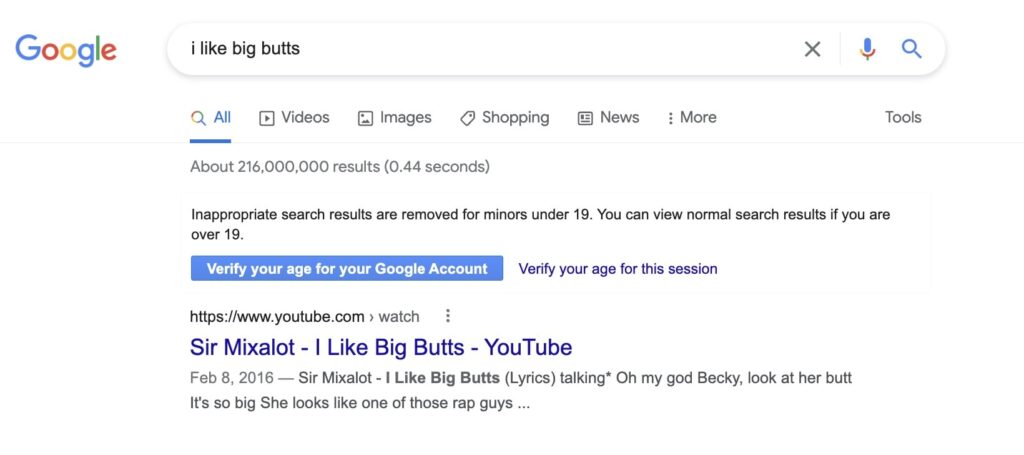
Of course, while living in Korea as a temporary foreigner, you can get past this restriction of the internet with a VPN. We use ExpressVPN these days and everywhere that we need privacy — when using public wifi, to watch streaming content abroad, or to get around firewalls. It’s fast and easy to use.
Getting a Sim card in Korea
Before arriving in Seoul, we got a Sim online at KT telecom, paying for it with our foreign credit card. Then we picked it up at the airport. It costs about $60 a month for unlimited data that’s about 50 Mbps (comparable to a good home internet service). It’s so fast that we never worried about it.
The price of $60 is pretty expensive. The plus side is that while we were living in Seoul, renewals were half price at $30 a month. I don’t know if that offer would continue, though.
The best part about using a sim phone service while living in Korea is that there’s cell service EVERYWHERE. This isn’t like America where service is patchy in remote areas, or like Europe where service is patchy when you enter a building. Nope — we could get service in the dingiest of cafes, or on top of mountain peaks. In fact, sometimes we’d do a hike to the top of a mountain, and some person at the top would be videoconferencing their family. (This is generally frowned upon, and rare, don’t worry.)
Part of this is because the culture in Korea is that it’s pretty much OK to always be on your phone — people watch videos or do social networking while walking around. It’s annoying, but if you like doing that, you’re free to do so now!
We can get service basically everywhere, including in buildings and even when going on hikes near Seoul. Of course, those cell towers sometimes get congested.
Public Wifi — Free and available
There’s a LOT of public Wifi in Seoul. There are very few places that don’t have a wifi connection you can use. You can pretty much assume every cafe will have it. The airport has it, and many shopping malls have it too.
On top of that, even some public transport has it (e.g., some long-distance buses), but those aren’t so good.
So even though your sim card is unlimited, you’ll be able to connect to a good wifi connection pretty often.
Outdoors stuff — Hiking, Climbing

Koreans are super outdoorsy. Hiking is a big part of living in Korea. So is climbing, including mountaineering.
We like hiking in a general “American” sense, which is a bit like what Australians call “bushwalking” but with more fancy equipment. So, we were pleased to see that Korea has a lot of trails and paths for walking up and around mountains, even some right in the middle of cities.

But what we didn’t expect was that Koreans are super into hiking and climbing. We saw people there of all ages, totally over-prepared for every situation. It’s not a slight on people’s hiking ability. It’s obvious people in Korea are super experienced and capable. I just saw a general higher level of gear for any given situation, than that which I was used to in America. For hikes of a few hours, I’d see people with a full top to bottom outfit of hiking gear, and often poles, a pack, hat, etc.
Oh, and Korean hikers do tend to cover up more for sun protection.
So, if you like hiking — you’re going to like living in Seoul!
Wrap up
After three months, we decided we’d come back to Korea every year or so. If for no other reason because we’ll have to keep improving our Korean!
I’m sure we’ll keep discovering more and more about Korea. But for the meantime, this hopefully is a good starting resource for you.

